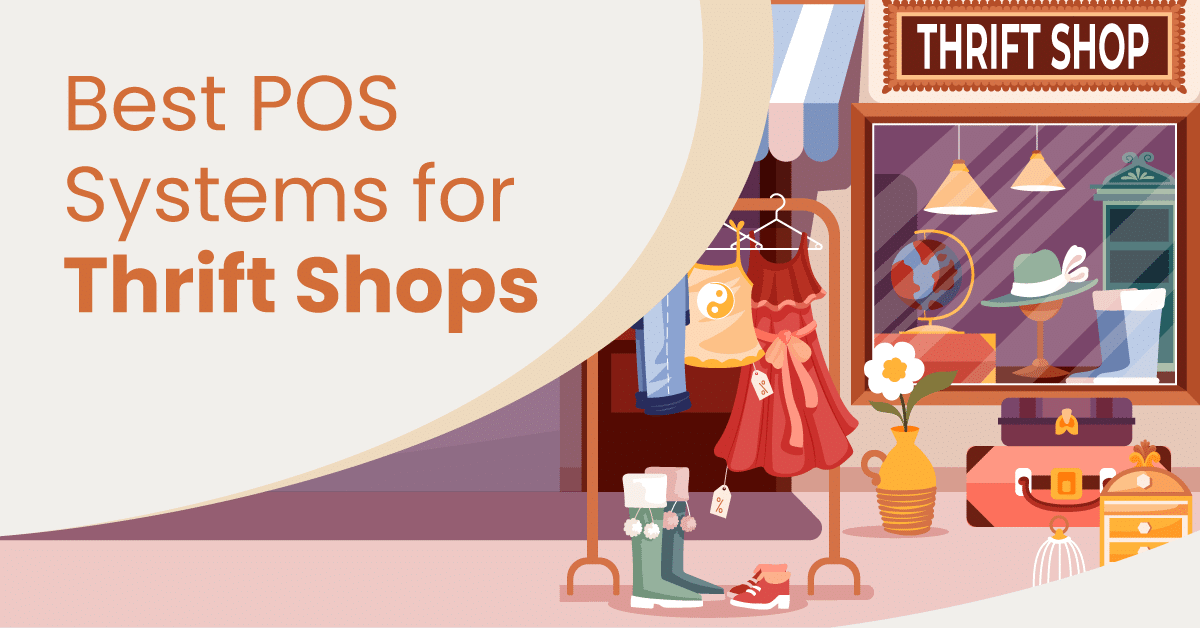This post aims to help thrift store owners choose the best POS systems for their thrift stores. Running a thrift store is fraught with so much unpredictability. You never know what items you’ll have in stock from one week to the next. Second, thrift store prices are mainly determined by the items’ quality, condition, and uniqueness. Third, thrift stores often classify and price items using various labeling systems, and unlike traditional retail stores, thrift shops often allow bargaining and haggling.
So, if you’re looking for a great POS system for thrift stores, these are some factors you should consider. You’ll need the best retail POS solution and software that can easily handle a high volume of new, used, and unique items. Read on to find out what could be the best thrift store POS for your store.
BEST POS System for Thrift Stores – A QUICK LOOK:
- Thiftcart: Best for thrift store specifics features
- KORONA POS: Best for credit card processing
- Loyverse: Best for its free features
- AccuPOS: Best for its intuitive design
- Shopify POS: Best for best for online selling
1. ThriftCart: Best For Thrift Store Specifics Features
Thriftcart overview
ThriftCart is a POS system for thrift stores, consignment shops, and non-profits. You can quickly add new donated items, categorize them, and track their location in your store. When an item sells, simply scan its tag to remove it from your records. The built-in barcode scanner makes it simple to check items in and out. ThriftCart also handles item bundling, allowing you to group and sell items for one price.

Pros
- Discount scheduling
- Great In-kind donation feature
- Cloud-based POS System
Cons
- Inventory management quirks
- Limited customization
Thriftcart Pricing
No pricing is available on the website.
ThriftCart is a solution developed by Nabadab LLC, a retail technology company. The software can run on tablets or Windows, depending on the user’s preference.
ThriftCart was founded in 2012 and has its headquarters in Langley, Washington State. Its biggest client is ReStore, a Habitat for Humanity thrift shop chain.
Key features
- Pricing flexibility: One of thrift stores’ biggest challenges is determining appropriate prices for various used goods. ThriftCart allows you to set prices based on item category, brand, condition, and knowledge of what sells in your local market. You can also run sales and discounts for certain categories or brands to move stale inventory.
- Reporting and analytics: ThriftCart provides reports that help you gain valuable insights into your business. See sales reports for your top-selling categories, brands, employees, and periods. Check reports on your inventory value, margins, and profits. All reports can be filtered for specific date ranges and exported to share with others. Use the data to make better pricing, staffing, and marketing decisions.
- Donations: ThriftCard POS Pickup Scheduling widget enables thrift stores to schedule, organize easily, and track pickups. Store owners can schedule multiple pickups, assign staff members to pickups, and set reminders, all from one central platform. ThriftCart’s drop-off donation management tool is pivotal in this process, offering eReceipts and maintaining records of the origin of donations, the items donated, and the time of donation.
- Discounting capability: One of the key features is the discounting capability, which allows for colored price tags to highlight discounted items, the ability to apply discounts to entire departments, and the option to offer special sales for volunteers or senior citizens.
- Receipts: ThriftCard streamlines the receipt process by enabling the printing of solid slips, sending electronic receipts (eReceipts), and scheduling automated thank-you messages.
- In-kind donation: The platform facilitates the management of in-kind donations by allowing for the tracking of repeat donations, geolocating donation areas, and forecasting donation cycles. These features aim to enhance operational efficiency, improve customer satisfaction, and promote sustainable practices within the thrift store ecosystem.
Pros
- Discount scheduling
- Cloud-based system
- Great customer service
Cons
- Web dependence
- Inventory management quirks
- Limited customization
Pricing
ThriftCrart does not provide a clear response on their pricing on their website. Therefore, you can only know what you will pay by contacting them to get a quote for your company based on the number of sites you have and your additional needs. However, some reviews on the pricing of ThriftCard suggest that it offers reasonable pricing, and there have yet to be complaints in this regard.
2. KORONA POS: Best For Credit Card Processing
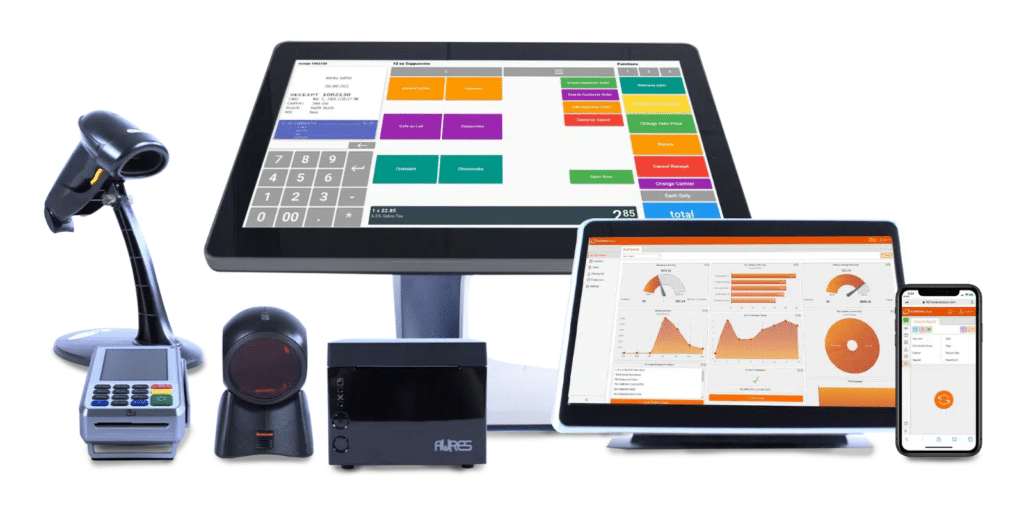
KORONA POS overview
KORONA POS is one of the most popular thrift store point of sale systems. In fact, it’s been specifically designed for thrift shops and consignment stores, both single locations and national chains. Here are some reasons why so many thrift shops choose KORONA POS.

Pros
- Excellent customer support
- ID customer verification
- Multi-store capacities
Cons
- Learning curve
- No sizing matrix capability
Korona POS Pricing
Core
$59/mo
Retail
$69/mo
Add-ons
$10-$50/mo
KORONA POS is a retail technology solution created by COMBASE USA, the American branch of COMBASE AG based in Germany. Established in 2011, COMBASE USA is headquartered in Las Vegas.
KORONA POS specializes in retail, catering to various sectors, including liquor, CBD, convenience, tobacco, books, etc. Additionally, the company offers solutions for wineries, amusement parks, QSRs, ticketed events, and multi-store franchises.
Key features
- Thrift shop order management: This feature helps owners run an efficient thrift store by tracking sales and inventory in real-time. KORONA POS allows for easy processing of sales, exchanges, and returns. It also helps manage special orders or consignments, ensuring all transactions are neatly tracked and organized.
- Automated inventory features: This reduces the risk of human error and saves time. KORONA POS software provides a real-time, automated inventory management system. It can help track the items sold, restocked, or those that need restocking or reordering.
- Donations by category: KORONA POS allows thrift store owners to categorize and track donations by specific categories. You can easily record and manage donations based on their type, such as clothing, accessories, furniture (Korona’s POS system is perfect for furniture stores, too!), electronics, etc. This feature simplifies the process of organizing and reporting on donated items.
- Native point-based loyalty system: This feature helps build customer loyalty by awarding points for purchases that can be redeemed later. KORONA POS has an integrated loyalty program feature, automatically tracking points within the customer profile, enhancing customer retention.
- Thrift shop product metrics: KORONA POS provides comprehensive product metrics specifically tailored for thrift stores. You can track sales performance, measure product profitability, and analyze item-level data to make informed pricing, inventory management, and promotions decisions.
- Chain and franchise management: Large thrift stores like Goodwill, The Salvation Army, and Savers have many locations. Keeping track of everything that’s going on in all these different places can be tough. They need to know what items they have, how sales are going, how their workers are doing, and what their customers like. KORONA POS makes it easy to keep an eye on all store locations, no matter where they are. It helps track what’s in stock, how well things are selling, and how employees are doing.
- Special thrift stores pricing and promotions: Thrift stores often use unique pricing and promotional strategies to attract customers and move inventory quickly. Some common instances include color-tag sales, daily or weekly specials, student, senior, or military discounts, Loyalty programs, and bag sales. KORONA POS can handle the most complex discounts based on what is entered on the receipt. Any discount you can think of can be set up as an automatic discount in KORONA POS without cashiers intervening. Setting up discounts may seem complicated or intimidating, but the KORONA POS support team will assist you during onboarding.
- Self-checkout kiosks & RFID technology: Due to the nature of thrift stores, where unique, one-of-a-kind items are frequently sold, ensuring an accurate and speedy inventory count is vital. RFID can read multiple tags simultaneously, unlike barcodes requiring individual line-of-sight scans, reducing queue lengths and improving customer satisfaction. KORONA POS offers that. RFID is a game-changer for big thrift stores, offering a more streamlined, error-free scanning process that meets the demands of their heavy sales traffic.
Pros
- Integration with any payment processor
- eCommerce POS integration
- Excellent customer support
Cons
- Less optimal for businesses requiring specific matrix-based inventory management for variable product sizes.
- Can be hard to understand and use, especially for people not used to complex systems like this.
- New users might need to spend time training and learning to use all the features.
Pricing
- KORONA Core: This basic plan costs $59 per month per terminal.
- KORONA Retail: This plan costs $69 per month per terminal and includes additional features compared to Core.
- KORONA Adds-on: Offers optional industry-specific modules that range from an additional $10 to $50 per month.
Schedule a KORONA POS Demo Today
Speak with a product specialist and learn how KORONA POS can power your business needs.
3. Loyverse POS: Best For Its Free Features
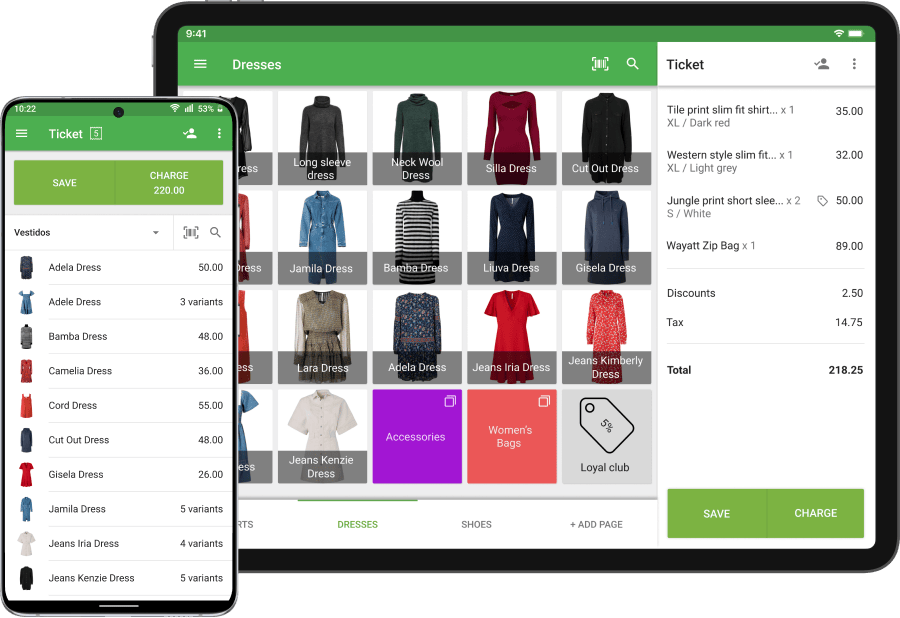
Loyverse POS overview
Loyverse POS is an ideal choice if you’re looking for an easy-to-use, full-featured point of sale system for your thrift store relatively inexpensive. With its simple interface, omnichannel and multichannel retail capabilities, and useful tools to help run your business efficiently, Loyverse POS has everything a small thrift store needs. The best part is it’s free to get started, so you can try it out risk-free.

Pros
- Cloud-based
- Great integration features
- Excellent mobile POS
Cons
- Limited customization
- Not great for PC users
Paid adds-on Loyverse POS Pricing
Employee management
$25/month per employee
Advanced inventory
$25/month per store
Integrations
$9/month per store
Loyverse stands for Loyalty Universe. The company was founded in 2014 and has its listed headquarters in Cyprus.
Loyverse has clients worldwide and serves several retail verticals including convenience, grocery, apparel, bike shops, furniture, bakeries, and more.
Key features
Some of the significant features of Loyverse POS include the following:
- Easy to set up and use: The interface is intuitive and requires no technical knowledge.
- Ring up sales and accept payments quickly: It supports cash, credit card, and contactless payments like Apple Pay.
- Track inventory in real-time: You can add, edit, or remove items and their details from the inventory list. Get notified when stock runs low.
- Insightful reports: Gain valuable insights into your sales, profits, inventory, and customer behavior with detailed reports and statistics. Use them to make better business decisions.
- Multiple store management: Easily manage multiple thrift store locations from a single account.
- Integrations: Loyverse POS integrates with many useful third-party services like accounting, email marketing, and loyalty programs. Connect them to streamline your operations.
Pros
- Scalable cloud-based system
- API access for developers
- Real-time reporting and insights
Cons
- Inventory and employee management are billed separately.
- Software is perceived as overly simplistic, raising concerns about value for cost.
- Platform compatibility is limited to smartphones or tablets, excluding PC users.
Pricing
- Employee management: $25/month per employee
- Advanced inventory: $25/month per store
- Integrations: $9/month per store
Free Features:
- Inventory management (basic)
- Loyverse KDS (Kitchen Display System)
- Loyverse CDS (Customer Display System)
To learn more about Loyverse’s pricing, click here.
4. AccuPOS: Best For Its Intuitive Design
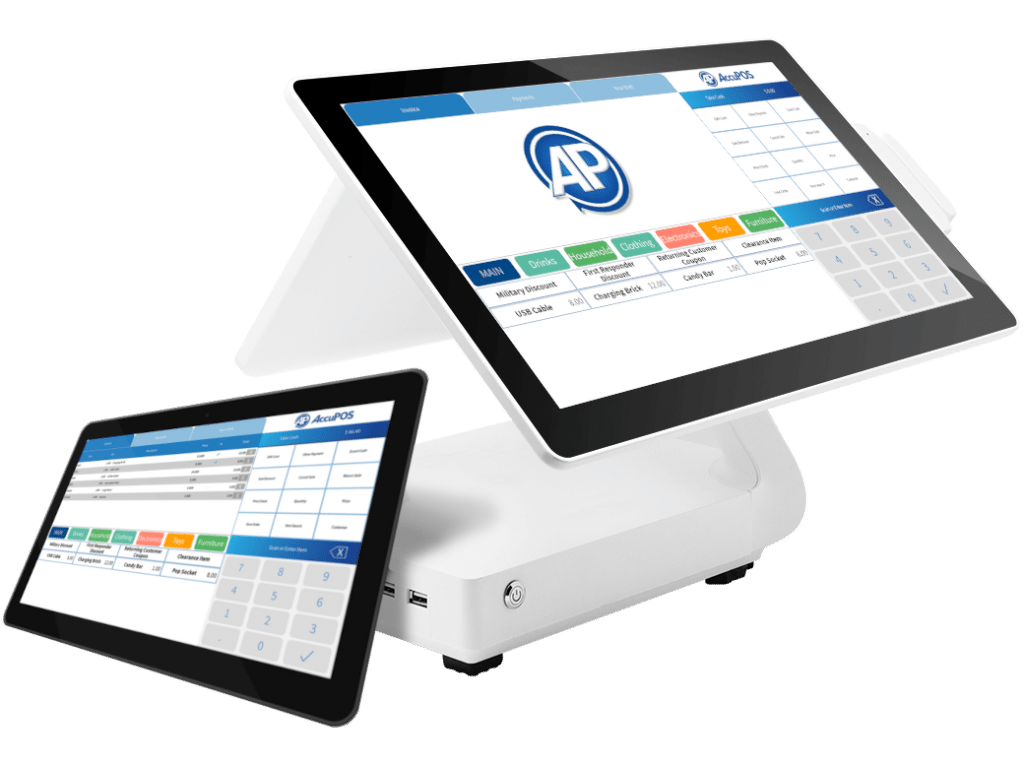
AccuPOS’s origins date back to 1999. Its current headquarters are in Worthington, Ohio.
The POS provider offers solutions for all types of businesses, from restaurants and retail stores to dispensaries and even golf courses.
AccuPOS overview
AccuPOS is an affordable POS system tailored for small businesses like thrift stores. It offers features like inventory management, customer loyalty programs, and reporting to help thrift stores gain insights into sales and profits.

Pros
- Seamless Integrations with Quickbooks
- Inventory management features
- Cost-effective
Cons
- Not great integration features
- Performance glitches
AccuPOS Pricing
No pricing is available on the website.
Key features
- Efficient reporting tools: The reporting features provide an overview of sales, margins, and trends so you can make data-driven decisions to improve your business and increase profits. See reports on your top-selling items, busiest hours, and more. Make it easier with real-time notifications, daily summaries, and a dashboard with every detail you need.
- Quick, precise inventory management: Thrift stores are flooded with daily arrivals, so tracking every item is tough. With AccuPOS Point of Sale and AccuCount, scanning new items, labeling, updating inventory, and managing your stock room and floor space becomes a breeze.
- Master discount pricing: Bargains and unique finds are your business’s backbone. AccuPOS can easily manage special deals and bulk sales using a user-friendly interface. Your customers and cashiers will appreciate the simplicity.
- Automated accounting: AccuPOS offers a top-notch automatic accounting software integration, one of the most useful automated retail tools. It sends all sale details to your accounting software, eliminating human error. You can see your financials whenever you want, helping you identify what’s selling and not. Make informed decisions for your store’s future. AccuPOS has topped the QuickBooks User Marketplace for seven consecutive years.
Pros
- AccuPOS is praised for its intuitive design
- Offers a good value proposition for mid-sized and larger businesses
- Integrates well with popular accounting software like QuickBooks
Cons
- Issues with system malfunctions and errors are frequent occurrences
- Assistance services provided need to be improved
- The pricing scheme needs to be more affordable for small businesses
- It does not mesh seamlessly with Sage 50
- Printing barcode labels involves complex processes and necessitates additional third-party software
Pricing
Pricing information for AccuPOS Retail is provided by the software supplier. Final negotiations for purchasing AccuPOS Retail must be conducted with the POS provider.
5. Shopify POS: Best For Online Selling
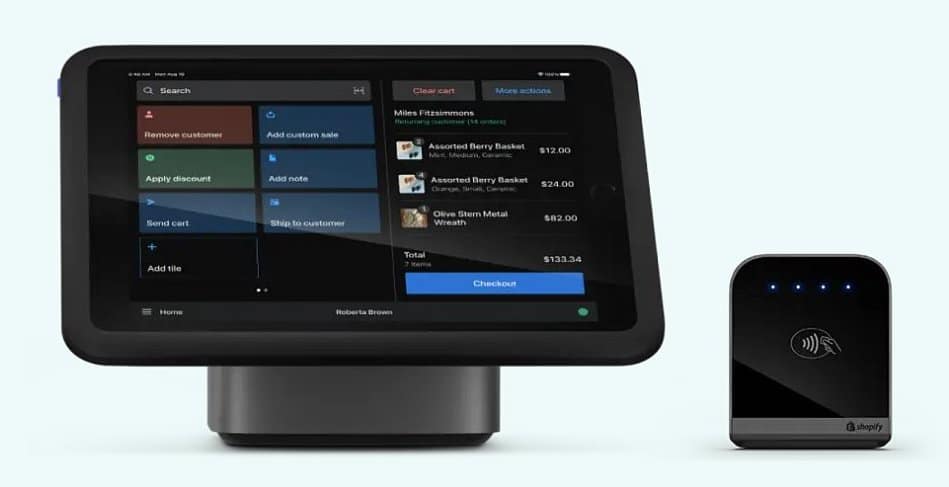
Shopify POS overview
Shopify POS is a top pick for nonprofit or for-profit thrift stores, especially those aiming for online and in-person sales. For charity stores, Shopify offers lower processing fees, unlimited staff accounts, real-time shipping, and the option to receive donations via Shopify Payments. Find below other reasons why Shopify POS is one of the best POS systems for thrift stores:
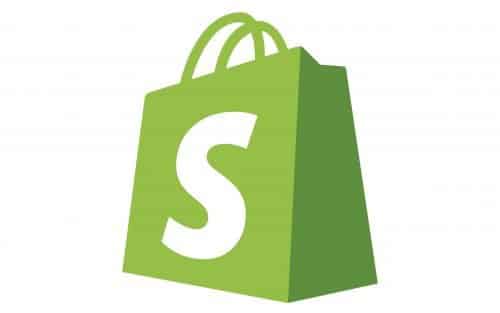
Pros
- Multi-channel selling
- Multi-store capacities
- Customer management
Cons
- Limited reporting and analytics
- Not ideal for only in-store sales
Shopify POS Pricing
Basic
$32/mo
Shopify
$92/mo
Advanced Shopify
$399/mo
Shopify POS was initially developed to power an online snowboard equipment store. It quickly evolved into a comprehensive eCommerce platform. In 2013, Shopify expanded its offerings to provide brick-and-mortar retailers with a POS to bridge their physical and online stores.
Their headquarters are in Ottawa with additional offices in Toronto, Montreal, and numerous other locations worldwide.
Key features
- Integrated payments: Accept chip cards, contactless payments like Apple Pay, and PIN debit right out of the box. Shopify POS uses the same integrated payment gateway as Shopify, with competitive rates.
- Inventory sync: Shopify POS offers eCommerce integration; inventory automatically syncs with your Shopify store inventory. When an item sells in-store, it is deducted from your overall stock numbers—no double data entry is required.
- Discounts and promotions: With a few taps, offer deals like percentage discounts, BOGOs, and fixed-amount markdowns. Discounts you create in Shopify POS will also show on your online store.
- Reporting and analytics: Gain insights into your sales, customers, and inventory with reports and dashboards in Shopify POS. Data from your POS and eCommerce sales are combined for a complete picture of your business.
Pros
- Allows you to sell in person, online, and even at pop-up shops.
- Can track quantities and variations (like sizes or colors)
- Provides comprehensive sales reports and analytics
Cons
- Shared payment account system may lead to security checks and funds being held for ‘suspicious’ transactions
- Difficulty in setting up remote workers for multiple store locations
- Lack of customization options to match unique business requirements
- Limited reporting and analytics capabilities
Pricing
- Basic: This plan costs $32 and is ideal for solo entrepreneurs with unlimited POS logins
- Shopify: This plan costs $92, is ideal for small teams, and provides five additional staff accounts
- Advanced: This plan costs $339, is ideal as your business scales, and provides 15 staff accounts
How To Find The Best POS System For Thrift Store
Finding the best POS system for your thrift store involves considering various factors to ensure it meets your needs. Here are the steps to help you in the process:
1. Identify your requirements
Begin by outlining your thrift store’s specific requirements. Consider factors such as the size of your store, the volume of transactions you handle, inventory management needs, integration with other systems (if any), and any unique features you might require.
2. Research available options
Conduct thorough research to explore the different POS systems available in the market. Look for systems that cater to retail businesses, particularly thrift stores. Read reviews, compare features, and consider the overall reputation and reliability of the providers.
3. Determine compatibility
Check the compatibility of the POS systems with your existing hardware and software infrastructure. Ensure the system integrates with your current devices, such as barcode scanners, receipt printers, cash drawers, and other necessary equipment.
4. Evaluate inventory management capabilities
As a thrift store, inventory management is crucial. Look for a retail POS system that offers a robust inventory management solution and features. This should include tracking stock levels, generating purchase orders, managing consignments (if applicable), and providing real-time updates on item availability.
5. Consider pricing and affordability
Assess the pricing models of different POS systems. Some providers charge monthly subscriptions, while others offer one-time payment options. Determine which pricing structure aligns with your budget and provides the best value for money. Consider any additional costs, such as hardware, software updates, or customer support.
6. Analyze reporting and metrics
Reporting capabilities are essential for monitoring the performance of your thrift store. Look for a POS system that provides comprehensive sales reports, transaction history, inventory analysis, and other relevant data. The system should offer easy-to-understand retail analytics to help you make informed business decisions.
7. Assess ease of use
A user-friendly interface is crucial for your staff’s efficiency and productivity. Ensure that the POS system you choose is intuitive and easy to navigate. Consider the support the provider offers to help train your staff to the new POS system.
8. Seek recommendations and references
Contact other thrift store owners or retailers in your network and ask for their advice. Learn from their experiences and ask about the POS systems they use. Additionally, request references from POS system providers to speak with their existing clients to gather more insights.
9. Consider customer support
Check the availability and quality of customer support provided by the POS system provider. Look for phone support, email support, live chat, or an online knowledge base. It’s essential to have reliable customer support to address any technical issues or questions that may arise.
10. Test the system with a free trial
Before making a final decision, request a demo or trial period from the shortlisted POS systems. This lets you explore the system’s features firsthand and determine if it meets your thrift store’s needs. During the trial, assess its performance, ease of use, and compatibility with your workflow.
Inventory management headache?
KORONA POS makes stock control easy. Automate tasks and get a clear picture of your entire inventory.
FAQs: Best POS Systems for Thrift Stores
How much do POS systems for thrift stores typically cost?
POS system pricing can range from free to several hundred dollars monthly for a thrift store. The cost depends on the number of features, users, and terminals you need. Many popular systems like Shopify POS, Loyverse POS, and ThriftCart offer free basic packages to get started. Paid plans typically range from $29 to $199 per month.
Do I need a POS system that is specifically for thrift stores?
Not necessarily. While some systems like ThriftCart are tailored specifically to thrift stores, many general retail POS systems will work fine for a thrift store. The essential features of a thrift store are a robust inventory management system, the ability to accept cash and card payments, and the ability to scan UPCs. As long as a system includes these capabilities, it can work well for a thrift store.
Should I get an iPad POS system or a traditional cash register?
For most thrift stores today, an iPad or tablet-based POS system is preferable to a traditional cash register. Tablet POS systems are less expensive, more mobile, and easier to set up and use. They also take up less counter space and can provide useful features like inventory management, customer profiles, and sales reporting that a basic cash register lacks. However, a cash register can still work for a very small thrift store and may save on costs. It comes down to your specific needs and technical abilities.
Conclusion on the Best Thrift Shop POS Systems
And that’s it, the top five POS systems ideally suited for thrift stores. As you’ve seen, there are affordable and flexible options designed with thrift stores in mind. The key is finding one that handles your specific needs, from managing unique inventories to seamless checkout.
With the right POS, you’ll be ringing up vintage finds and secondhand scores quickly. What are you waiting for? Take your thrift store into the 21st century and choose a POS to help your business and customers thrive. The future of thrift retail is here.


